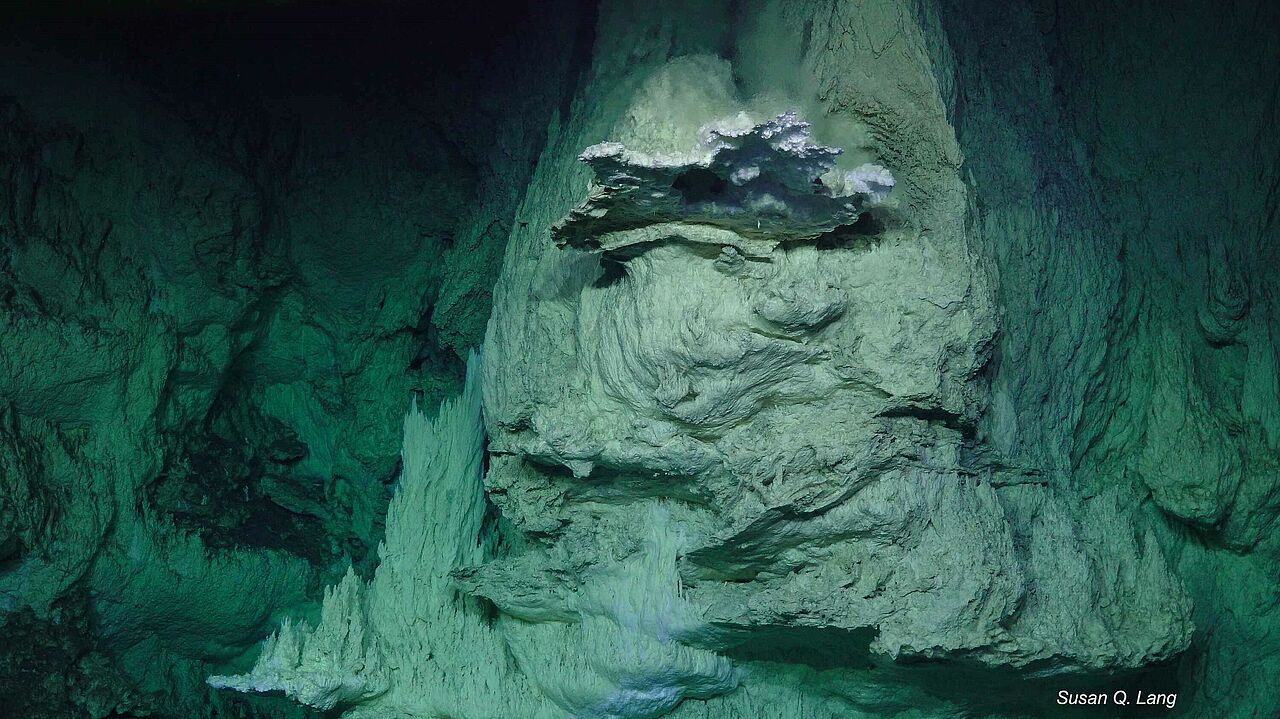In order to harvest energy, cells first have to push the electrons from H2 energetically uphill. “That is like asking a river to flow uphill instead of downhill, so cells need engineered solutions,” explains one of the three first authors of the study, Max Brabender. How cells solve that problem was discovered only 15 years ago by Wolfgang Buckel together with his colleague Rolf Thauer in Marburg. They found that cells send the two electrons in hydrogen down different paths. One electron goes far downhill, so far downhill that it sets something like a pulley (or a siphon) in motion that can pull the other electron energetically uphill. This process is called electron bifurcation. In cells, it requires several enzymes that send the electrons uphill to an ancient and essential biological electron carrier called ferredoxin. The new study shows that at pH 8.5, typical of naturally alkaline vents, “no proteins are required,” explains Buckel, coaouthor of the study, “the H–H bond of H2 splits on the iron surface, generating protons that are consumed by the alkaline water and electrons that are then easily transferred directly to ferredoxin.”
How an energetically uphill reaction could have worked in early evolution, before there were enzymes or cells, has been a very tough puzzle. “Several different theories have proposed how the environment might have pushed electrons energetically uphill to ferredoxin before the origin of electron bifurcation,“ says Martin, “we have identified a process that could not be simpler and that works in the natural conditions of hydrothermal vents”.
Since the discovery of electron bifurcation, scientists have found that the process is both ancient and absolutely essential in microbes that live from H2. The vexing problem for evolutionarily-minded chemists like Martina Preiner, whose team in Marburg focusses on the impact of the environment on reactions that microbes use today and possibly used at life’s origin, is: How was H2 harnessed for CO2 fixing pathways before there were complicated proteins? “Metals provide answers,”, she says, “at the onset of life, metals under ancient environmental conditions can send the electrons from H2 uphill, and we can see relicts of that primordial chemistry preserved in the biology of modern cells.” But metals alone are not enough. “H2 needs to be produced by the environment as well” adds co-first author Delfina Pereira from Preiner’s lab. Such environments are found in hydrothermal vents, where water interacts with iron-containing rocks to make H2 and where microbes still live today from that hydrogen as their source of energy.
Hydrothermal vents, both modern and ancient, generate H2 in such large amounts that the gas can turn iron-containing minerals into shiny metallic iron. “That hydrogen can make metallic iron out of minerals is no secret” says Harun Tüysüz, expert for high-tech materials at the Max-Planck-Institut für Kohlenforschung Mülheim and coauthor on the study. “Many processes in chemical industry use H2 to make metals out of minerals during the reaction.” The surprise is that nature does this too, especially at hydrothermal vents, and that this naturally deposited iron could have played a crucial role at the origin of life.
Iron was the only metal identified in the new study that was able to send the electrons in H2 uphill to ferredoxin. But the reaction only works under alkaline conditions like those in a certain type of hydrothermal vents. Natalia Mrnjavac from the Düsseldorf group and co-first author on the study points out: “This fits well with the theory that life arose in such environments. The most exciting thing is that such simple chemical reactions can close an important gap in understanding the complex process of origins, and that we can see those reactions working under the conditions of ancient hydrothermal vents in the laboratory today.”
Originalpublikation
Max Brabender, Delfina P. Henriques Pereira Natalia Mrnjavac, Manon Laura Schlikker, Zen-Ichiro Kimura, Jeerus Sucharitakul, Karl Kleinermanns, Harun Tüysüz, Wolfgang Buckel, Martina Preiner, and William F. Martin. Ferredoxin reduction by hydrogen with iron functions as an evolutionary precursor of flavin-based electron bifurcation. Proc. Natl. Acad Sci. USA. https://doi.org/10.1073/pnas.2318969121


